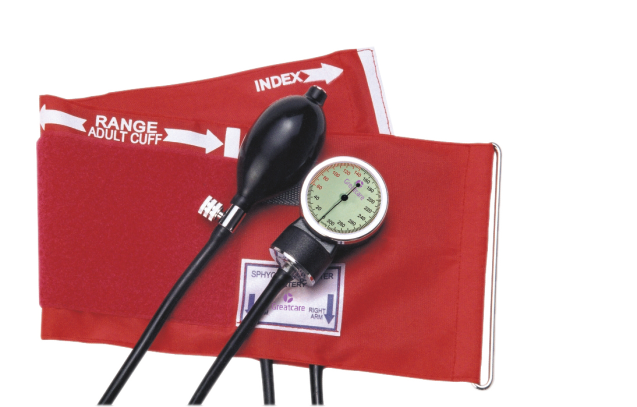
Aneroid Sphygmomanometer
When visiting your doctor for a checkup, it's important to get an accurate reading of your blood pressure. But have you ever wondered how this information is gathered? The answer lies in the Aneroid Sphygmomanometer, the silent workhorse of the doctor's office. Find out more in this article about the history and importance of this device.
Measure scope: 0-300mmHg
Accuracy:+/-3mmHg
Sub-division:2mmHg
Available in Nylon cuff or Cotton cuff.
Cuff Size:neonate- 25x5cm, infant- 38x7cm, child- 45x10.5cm, adult- 50x14cm, thigh- 62x17cm
Available in with D-ring or without D-ring.
Available in PVC bulb, PVC inflation system or latex bulb, latex inflation system.
Available in stop-pin or non-stop-pin.
Available in different colors of tubing and cuff.
| Ref. No.: | Description: | Qty.Cs: |
|---|---|---|
| NMDE310102 | Green nylon cuff, latex bulb, non-stop-pin | 50 |
| NMDE310204 | Blue nylon cuff, PVC bulb, non-stop-pin | 50 |
| NMDE320204 | Blue cotton cuff, latex bulb, non-stop-pin, w/D-ring | 50 |
| NMDE310306 | Red nylon cuff, PVC bulb, non-stop-pin, w/D-ring | 50 |
The aneroid sphygmomanometer is a simple, yet essential tool in the doctor's office. It is used to measure blood pressure, and can be found in most medical offices and clinics. The aneroid sphygmomanometer consists of a cuff, which is placed around the arm, and a gauge, which is used to measure the pressure. The cuff is inflated with air, and the pressure is then released. The gauge measures the pressure as it decreases. The aneroid sphygmomanometer is a reliable way to measure blood pressure, and is often used in conjunction with other tests, such as a stethoscope, to get a complete picture of a patient's health.
The aneroid sphygmomanometer is a simple, yet essential, piece of medical equipment that is used to measure blood pressure. It consists of a cuff that is wrapped around the upper arm and inflated to temporarily stop the flow of blood. A mercury or aneroid gauge is then used to measure the pressure in the cuff, which is an indicator of the patient's systolic blood pressure. While the exact mechanism by which an aneroid sphygmomanometer works is not fully understood, it is thought that the cuff works by compressing the brachial artery (the main artery in the upper arm) and temporarily stopping the flow of blood. The mercury or aneroid gauge then measures the pressure in the cuff, which is directly related to the patient's systolic blood pressure. Aneroid sphygmomanometers are simple, yet essential, pieces of medical equipment that are used extensively in doctor's offices, hospitals, and clinics around the world. They are relatively inexpensive and easy to use, making them a valuable tool in diagnosing and treating high blood pressure.
An aneroid sphygmomanometer is a device used to measure blood pressure, composed of an inflatable cuff to collapse and release the artery under the cuff in a controlled manner, and a mercury or aneroid manometer to measure the pressure The cuff is an inflatable rubber bladder that encircles the upper arm and is inflated with a hand bulb and valve. The mercury manometer consists of a mercury-filled glass tube with a scale calibrated in millimeters of mercury (mmHg). The aneroid manometer uses a small, delicate mechanism instead of mercury. It is less accurate than the mercury manometer but more portable. The stethoscope is used to listen for Korotkoff sounds which are faint tapping noises that correspond to the onset and disappearance of pulsations in the artery as the cuff pressure is lowered and released. The systolic blood pressure is read as the first appearance of these sounds, while the diastolic blood pressure is read as the disappearance of these sounds.
The aneroid sphygmomanometer is a device that is used to measure blood pressure. It consists of a cuff that is placed around the arm, and a mercury column that is attached to the cuff. The mercury column is used to measure the pressure of the blood in the arteries. The aneroid sphygmomanometer is a very accurate device, and it can be used to measure the blood pressure of people of all ages.
An aneroid sphygmomanometer is a simple, yet essential, tool used by doctors to measure blood pressure. It consists of a cuff that is inflated around the upper arm and a mercury or aneroid gauge. There are several benefits to using an aneroid sphygmomanometer. First, it is relatively inexpensive compared to other blood pressure measuring devices. Second, it is portable and easy to use. Third, it does not require electricity to operate, making it ideal for use in resource-limited settings. There are also some drawbacks to using an aneroid sphygmomanometer. First, mercury sphygmomanometers are being phased out due to the health risks associated with mercury exposure. Second, aneroid sphygmomanometers can be less accurate than digital blood pressure monitors. Finally, they require regular calibration to ensure accuracy.